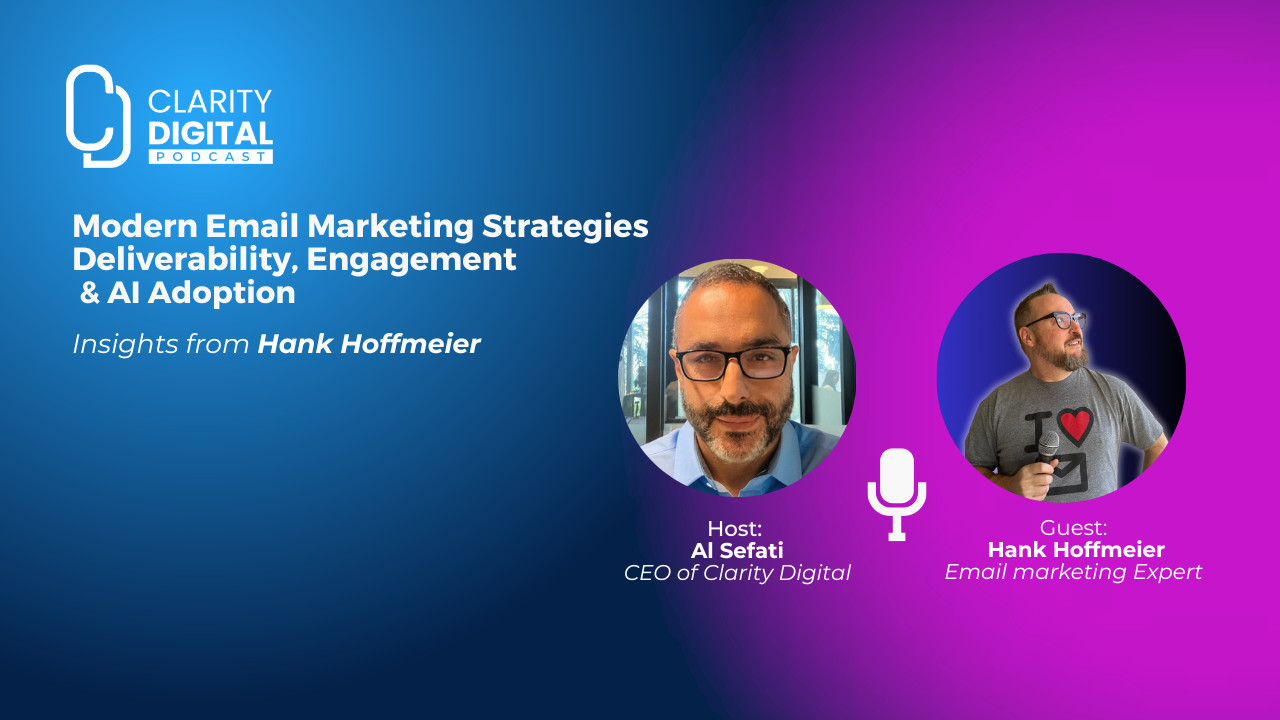Insights from the Clarity Digital Pod Podcast Featuring Hank Hoffmeier
Email marketing continues to be one of the most effective and enduring marketing tools, adapting to the demands of AI-driven innovation, evolving privacy regulations, and advanced deliverability methods. In a recent episode of Clarity Digital Pod, Al Sefati interviewed Hank Hoffmeier, an esteemed email marketing strategist from Kickbox, to explore the future of email marketing in 2025. Their discussion covered the transformative impact of AI on automation and personalization and the essential practices businesses must adopt to enhance engagement, compliance, and deliverability.
This article presents a comprehensive analysis of their discussion, offering actionable takeaways for modern businesses. Topics include:
- Cutting-edge email marketing strategies that leverage AI to optimize campaigns
- Common mistakes marketers should avoid to maintain compliance and build trust
- Best practices for improving email deliverability and fostering engagement
By implementing these strategies, businesses can position themselves for sustained success in a competitive digital landscape. Whether you are refining your email campaigns or looking to stay ahead of industry trends, these insights provide a clear roadmap for achieving measurable results.
The State of Email Marketing in 2025: Is Email Still Relevant?
For years, email marketing has been questioned, with frequent claims that it’s becoming obsolete. However, as expert Hank Hoffmeier asserts, email marketing remains a powerful and indispensable tool. Despite the growing influence of social media and messaging platforms, email continues to be a cornerstone of digital communication, required for key online interactions such as account registrations, purchase confirmations, and essential business updates.
The Enduring Power of Email Marketing
- Email Is a Direct-Owned Channel
- Unlike social media, where brands are subject to algorithm changes and platform policies, email provides businesses with direct access to their audience and full control over messaging.
- Email lists represent a long-term business asset; even if a social platform becomes irrelevant, email remains a sustainable and reliable communication channel.
- Personalization and Segmentation Enhance Effectiveness
- With advancements in AI-driven tools, businesses can create hyper-personalized email campaigns, delivering content that is highly relevant and engaging for recipients.
- Audience segmentation ensures that different subscriber groups receive targeted, tailored content, leading to higher engagement and conversion rates.
- Privacy Changes Are Reshaping Email Metrics
- Recent developments, such as Apple’s Mail Privacy Protection (MPP), have made open rates a less reliable performance indicator.
- Marketers are now prioritizing metrics like click-through rates (CTR), conversions, and audience retention, which better reflect the effectiveness of email campaigns in driving results.
- AI and Automation Are Revolutionizing Email Marketing
- Artificial intelligence is transforming email marketing by enabling smart subject line generation, predictive analytics, and personalized content recommendations.
- Automation workflows allow businesses to deliver the right message at the right time, increasing efficiency and maximizing impact.
Email Marketing’s Role in the Digital Landscape
As technology evolves, email marketing continues to adapt, solidifying its role as an essential digital marketing channel. Its ability to provide direct communication, leverage personalization, and embrace advancements such as AI makes it a critical tool for businesses aiming to connect with their audience effectively. While challenges such as privacy changes impact certain metrics, they also push marketers to focus on more meaningful outcomes like conversions and retention.
Email marketing is not just surviving—it is thriving. Businesses that harness its potential will find themselves better equipped to engage their audience, foster loyalty, and drive growth in an increasingly digital world.
How AI Is Revolutionizing Email Marketing
Artificial intelligence (AI) has emerged as a transformative force in email marketing, enabling unprecedented levels of efficiency, personalization, and automation. By leveraging AI, businesses can optimize their email strategies to enhance engagement and drive results.
1. AI-Generated Subject Lines and Email Content
AI-powered tools are redefining how marketers craft email content:
- They analyze key campaign details to create, refine, and optimize subject lines, ensuring higher open rates.
- AI generates multiple variations of subject lines, aligning them with audience intent and campaign objectives.
2. Advanced Personalization Through AI
Personalization has become a cornerstone of effective email marketing:
- AI analyzes customer behavior, purchase history, and prior interactions to produce dynamic, tailored content for each recipient.
- Unlike traditional mass emails, AI empowers businesses to deliver highly relevant, personalized messages at scale, fostering stronger customer connections.
3. Intelligent Email Automation
AI enhances marketing workflows by introducing adaptive automation:
- It builds workflows that adjust in real time based on user behavior, ensuring timely and relevant communication.
- For example, if a customer abandons their cart, AI can promptly trigger a personalized email sequence designed to encourage purchase completion.
4. Optimized Send Times and Frequency
The timing and frequency of email campaigns significantly impact their effectiveness:
- AI analyzes historical engagement data to identify the optimal moments to send emails, maximizing subscriber engagement.
- This minimizes the risks of over-emailing or under-emailing, ensuring that messages reach recipients when they are most receptive.
5. Real-Time Insights and Performance Reporting
AI provides marketers with robust analytics to fine-tune their strategies:
- Real-time insights into email performance enable quick adjustments to optimize campaigns.
- Key metrics, such as open rates, click-through rates, and conversions, are analyzed to guide data-driven decision-making.
By integrating AI into email marketing, businesses can streamline their processes, enhance personalization, and achieve measurable outcomes. As AI technology continues to evolve, its role in email marketing is set to grow, empowering organizations to deliver impactful, data-driven campaigns that resonate with their audiences.
Email Deliverability: Ensuring Your Messages Reach the Inbox
Email deliverability remains one of the most critical challenges in email marketing. Ensuring that emails land in recipients’ inboxes, rather than their spam folders, is essential for the success of any campaign. Hank Hoffmeier provided valuable insights into strategies that help businesses enhance email deliverability and maintain a strong sender reputation.
1. The Importance of Email Validation
Sending emails to outdated, invalid, or fake addresses can severely harm your sender reputation and reduce the effectiveness of campaigns. Leveraging tools such as Kickbox allows businesses to validate email addresses before sending, ensuring that only genuine and engaged subscribers are targeted. This proactive approach not only safeguards your reputation but also improves overall campaign performance.
2. Implementing Email Authentication Protocols
Email authentication is a cornerstone of a trusted email marketing strategy. Protocols such as SPF (Sender Policy Framework), DKIM (DomainKeys Identified Mail), and DMARC (Domain-based Message Authentication, Reporting & Conformance) play a crucial role in preventing spoofing and phishing attacks. These measures establish legitimacy, ensuring that email providers recognize and trust your communications, thereby improving deliverability rates.
3. Preventing Spam Filter Triggers
Spam filters evaluate emails based on engagement metrics like clicks, responses, and interactions. Low engagement resulting from irrelevant or poorly targeted emails increases the likelihood of messages being flagged as spam. By creating highly relevant and well-targeted content, businesses can maintain high engagement levels, reduce complaints, and improve deliverability outcomes.
4. Maintaining List Hygiene
Regularly cleaning email lists is an essential practice for preserving a positive sender reputation. Removing inactive subscribers—those who have not engaged in months—helps improve engagement rates and ensures that emails are directed at an active, interested audience. This ongoing maintenance enhances deliverability and supports long-term email marketing success.
Key Takeaway
By focusing on email validation, authentication, relevance, and list hygiene, businesses can significantly improve email deliverability and maintain a strong sender reputation. Implementing these best practices ensures that your campaigns effectively reach the intended audience and achieve meaningful results.
Effective Email Marketing Strategies for Various Business Models
Email marketing strategies should align with your business model to drive meaningful results. Below are tailored approaches for B2B, B2C, and nonprofit organizations, designed to maximize impact and achieve specific goals.
1. B2B Email Marketing
In the B2B sector, email campaigns should prioritize delivering value through educational and actionable content. Consider the following strategies:
- Share high-value resources such as whitepapers, case studies, and industry reports to establish authority and build trust.
- Personalize communications by incorporating recipient-specific details, such as company names and addressing their unique challenges or pain points.
- Leverage email automation tools to streamline lead nurturing, ensuring timely follow-ups and consistent engagement throughout the sales funnel.
2. B2C Email Marketing
For consumer-focused businesses, email marketing should aim to capture attention and encourage immediate action. Key practices include:
- Highlight personalized product recommendations and exclusive offers to drive engagement and sales conversions.
- Craft compelling subject lines and incorporate visually appealing, dynamic content to create an engaging user experience.
- Implement cart abandonment email workflows to recover potential lost revenue by reminding customers about products left in their shopping carts.
3. Nonprofit Email Marketing
Nonprofit organizations can significantly enhance donor engagement through email campaigns that foster emotional connections and trust. The following strategies are essential:
- Utilize storytelling techniques to communicate the real-world impact of your organization’s initiatives and inspire action.
- Emphasize impact metrics to demonstrate transparency and highlight how donations contribute to meaningful change.
- Include prominently placed, easy-to-use donation buttons supported by clear and persuasive calls to action (CTAs) to encourage immediate contributions.
By tailoring your email marketing approach to your specific business model, you can create campaigns that resonate with your target audience, enhance engagement, and drive measurable results.
How Often Should You Send Emails?
The ideal email frequency depends on industry, audience preferences, and business objectives.
- B2B: Two to four emails per month (newsletters, product updates, events).
- B2C: One to three emails per week (promotions, product launches).
- Nonprofits: Weekly to monthly updates, depending on fundraising campaigns.
A/B testing helps businesses find the right cadence based on subscriber engagement levels.
Essential Email Marketing KPIs to Monitor
In today’s evolving digital landscape, Hank underscored that open rates are no longer the most dependable metric due to recent privacy updates. To accurately measure the performance of your email marketing campaigns, businesses should prioritize the following key performance indicators (KPIs):
- Click-through rate (CTR): This metric evaluates how effectively your email content engages recipients, measuring the percentage of users who click on links within your emails.
- Conversion rate: Tracks the proportion of recipients who complete a desired action, such as making a purchase or signing up for a service, after engaging with your email.
- List growth rate: An important indicator of your audience’s expansion or decline, this metric highlights the success of your subscriber acquisition strategies.
- Unsubscribe and spam complaint rates: Monitoring these rates is critical for identifying areas where engagement may be faltering and ensuring compliance with best practices.
By shifting focus to these KPIs, businesses can gain deeper insights into email performance, refine their strategies, and ultimately drive more meaningful results.
Should Businesses Outsource Email Marketing or Manage It In-House?
Deciding whether to manage email marketing internally or partner with an agency is a critical decision for businesses seeking to maximize their marketing effectiveness. Each approach has unique advantages depending on your organization’s resources, expertise, and goals.
- In-House Management: This option is most effective for companies with well-established marketing teams and a deep understanding of their brand identity. By managing email marketing internally, businesses can maintain complete control over messaging and ensure alignment with their broader marketing strategy.
- Outsourcing to an Agency: For organizations that require specialized expertise, access to advanced tools, or dedicated email marketing professionals, outsourcing is an excellent solution. Agencies bring industry knowledge and strategic insights, enabling businesses to implement sophisticated campaigns without overburdening internal teams.
- Hybrid Approach: Many brands adopt a blended model, leveraging the strengths of both in-house and outsourced strategies. Agencies can take the lead on campaign strategy and execution, while internal teams focus on content creation and audience segmentation to ensure brand consistency.
By carefully assessing your team’s capacity and goals, you can determine the approach that will deliver the greatest value to your organization.
Modern Email Marketing StrategiesKey Takeaways
Email marketing is undergoing significant transformation, driven by advancements in AI, automation, and evolving regulatory frameworks. To remain competitive, businesses must prioritize key areas such as engagement, deliverability, and personalization.
Actionable Steps for Success:
- Focus on creating personalized, value-driven email campaigns to enhance customer engagement.
- Leverage automation tools to improve efficiency and scalability.
- Ensure compliance with email regulations to maintain trust and credibility.
For those looking to elevate their email marketing strategies:
- Visit HankHoffmeier.com or Follow Hank Hoffmeier on LinkedIn for expert guidance and industry insights.
- Explore Kickbox.com for reliable email validation services to enhance deliverability.
For comprehensive digital marketing solutions, consider partnering with Clarity Digital Agency to achieve measurable results and long-term growth.





